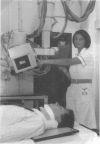Abstract
OBJECTIVE: To determine whether a swimmer's view or supine (trauma) oblique views are more likely to visualise the lower cervical spine when a lateral view fails to show the cervicothoracic junction. DESIGN: A prospective study comparing two 20 week periods. In the first phase the swimmer's view was performed as an additional view when the cervicothoracic junction was not demonstrated. In the second phase paired supine oblique views replaced the swimmer's view. RESULTS: 230 patients were included in the first phase, of whom 60 required swimmer's views. In the second phase 62 of 197 patients required supine oblique views. Radiology analysis of 53 pairs of supine oblique views showed that the vertebral bodies were adequately demonstrated at the cervicothoracic junction in only 20 patients (38%) compared with 22 in the swimmer's group (37%). The facet joints and posterior elements were, however, clearly seen in 37 (70%) of the supine oblique patients compared with 22 (37%) of the swimmer's group (p < 0.001, chi2 test). Exposure dose calculations showed a substantial reduction for a pair of supine oblique views (1.6 mGy) over a single swimmer's view (7.2 mGy). CONCLUSIONS: In injured patients for whom the standard three view series fails to demonstrate the cervicothoracic junction, swimmer's views and supine oblique views show the alignment of the vertebral bodies with equal frequency. However, supine oblique films are safer, expose patients to less radiation, and are more often successful in demonstrating the posterior elements.
Full text
PDF



Images in this article
Selected References
These references are in PubMed. This may not be the complete list of references from this article.
- Daffner R. H. Evaluation of cervical vertebral injuries. Semin Roentgenol. 1992 Oct;27(4):239–253. doi: 10.1016/0037-198x(92)90003-k. [DOI] [PubMed] [Google Scholar]
- Kaufman H. H., Harris J. H., Jr, Spencer J. A., Kopanisky D. R. Danger of traction during radiography for cervical trauma. JAMA. 1982 May 7;247(17):2369–2369. [PubMed] [Google Scholar]
- Moulton C., Griffiths P. D. The adequacy of cervical spine radiographs in the accident and emergency department. J R Soc Med. 1993 Mar;86(3):141–143. doi: 10.1177/014107689308600308. [DOI] [PMC free article] [PubMed] [Google Scholar]
- Murphey M. D. Trauma oblique cervical spine radiographs. Ann Emerg Med. 1993 Apr;22(4):728–730. doi: 10.1016/s0196-0644(05)81857-8. [DOI] [PubMed] [Google Scholar]
- Streitwieser D. R., Knopp R., Wales L. R., Williams J. L., Tonnemacher K. Accuracy of standard radiographic views in detecting cervical spine fractures. Ann Emerg Med. 1983 Sep;12(9):538–542. doi: 10.1016/s0196-0644(83)80293-5. [DOI] [PubMed] [Google Scholar]
- Turetsky D. B., Vines F. S., Clayman D. A., Northup H. M. Technique and use of supine oblique views in acute cervical spine trauma. Ann Emerg Med. 1993 Apr;22(4):685–689. doi: 10.1016/s0196-0644(05)81848-7. [DOI] [PubMed] [Google Scholar]




